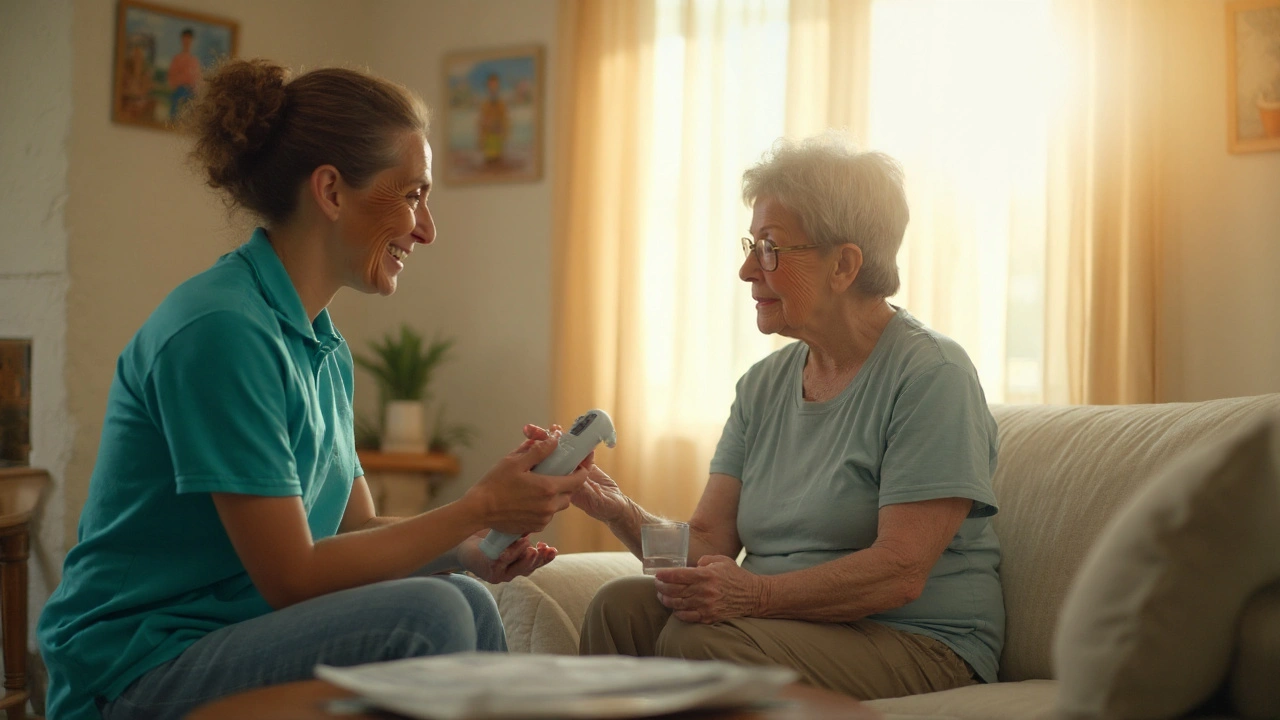
Occupational Therapy is a rehabilitative health profession that focuses on enabling individuals to perform everyday activities despite physical or cognitive challenges. When it comes to breathing disorders, OTs bring a unique blend of functional training, adaptive strategies, and patient education that goes beyond medication or traditional respiratory therapy.
What Counts as a Breathing Disorder?
Breathing Disorder refers to any condition that impairs the body’s ability to inhale, exhale, or exchange gases efficiently. Common examples include chronic obstructive pulmonary disease (COPD), asthma, interstitial lung disease, and post‑viral sequelae such as long COVID. These conditions often lead to reduced exercise tolerance, fatigue, and difficulty completing activities of daily living (ADLs).
The OT Lens: Why It Matters for the Lungs
From an OT perspective, the lungs are just one piece of the functional puzzle. The goal is to keep the person engaged in meaningful roles-whether that’s cooking dinner, caring for a child, or returning to work. To do that, OTs assess:
- Respiratory muscle strength and endurance
- Postural alignment that supports optimal lung expansion
- Energy‑conservation techniques for daily tasks
- Environmental barriers that increase breathlessness
These insights guide the creation of individualized plans that blend therapeutic exercises with real‑world adaptations.
Core Interventions That OT Brings to the Table
The following interventions are the backbone of OT practice for breathing disorders:
- Respiratory Muscle Training: Using handheld devices or graduated breathing exercises to strengthen the diaphragm and accessory muscles.
- Postural Re‑education: Adjusting sitting and standing positions to expand thoracic cavity and reduce dyspnea during tasks.
- Energy‑Conservation Strategies: Teaching paced breathing, task segmentation, and the "4‑step" approach (plan, prioritize, perform, review) to minimize fatigue.
- Adaptive Equipment: Introducing items like lightweight kitchen tools, shower chairs, or portable inhaler holders that reduce exertion.
- Home Exercise Programs: Crafting short, daily routines that reinforce clinic‑based gains and promote self‑efficacy.
- Patient Education: Explaining disease mechanisms, proper inhaler technique, and signs of exacerbation.
Each of these components is tailored to the person’s goals, whether that’s climbing a set of stairs without stopping or simply being able to read a book comfortably.
Occupational Therapy vs. Physical Therapy in Pulmonary Care
| Aspect | Occupational Therapy | Physical Therapy |
|---|---|---|
| Primary Focus | Functional performance of daily activities | Body mechanics, movement patterns, and endurance |
| Typical Interventions | Task‑specific breathing drills, ADL adaptations, energy‑conservation training | Exercise tolerance training, aerobic conditioning, manual therapy |
| Target Population | Patients needing support to return to home‑based roles | Patients requiring strength, balance, or gait improvement |
| Clinical Setting | Outpatient OT, home health, community‑based programs | Cardiac rehab, outpatient PT, inpatient rehab units |
Both disciplines often collaborate within a Pulmonary Rehabilitation program, but the OT lens adds a layer of real‑world functionality that bridges the gap between improved lung capacity and independent living.

Embedding OT in the Interdisciplinary Team
Successful management of breathing disorders relies on an interdisciplinary approach. The typical team includes pulmonologists, respiratory therapists, physical therapists, dietitians, and social workers. Within this framework, OT contributes by:
- Conducting comprehensive occupational assessments that capture home‑environment challenges.
- Coordinating with respiratory therapists to integrate breathing exercises into ADL training.
- Providing education materials that align with the medical team’s medication and inhaler instructions.
This collaboration ensures that every therapeutic gain translates into a tangible improvement in daily life.
How Success Is Measured
Outcome measurement is essential for tracking progress and adjusting plans. Common OT‑specific tools include:
- Canadian Occupational Performance Measure (COPM) - captures self‑reported performance and satisfaction in chosen activities.
- Six‑Minute Walk Test (6MWT) - while originally a PT metric, OTs use it to gauge endurance during functional tasks.
- Modified Borg Dyspnea Scale - rates perceived breathlessness during specific activities.
Data from these tools guide refinements such as increasing respiratory muscle training intensity or swapping an adaptive kitchen utensil for a more efficient model.
Real‑World Case Snapshots
Case 1 - COPD Home‑Cook: Maria, 68, struggled to stir a pot without coughing. An OT assessment revealed that the high‑back stove height forced her into a forward‑leaning posture, compressing her diaphragm. By recommending a lower stovetop and a lightweight, ergonomic whisk, her cooking time dropped by 30% and dyspnea scores improved dramatically.
Case 2 - Asthma Teacher: Alex, 34, experienced panic attacks during lesson planning because he felt short‑of‑breath while writing on a whiteboard. OT introduced paced breathing cues synced with his hand‑writing rhythm and supplied a portable tablet stand, allowing him to maintain an upright posture and reduce his inhaler use during work hours.
These examples illustrate how OT bridges the clinical‑to‑daily‑life divide, turning physiological improvements into functional independence.
Related Concepts Worth Exploring
Understanding OT’s role opens doors to several adjacent topics. Readers may also want to learn about:
- Respiratory Muscle Training - the science behind using devices like threshold inspiratory trainers.
- Adaptive Equipment - selecting tools that reduce exertion without compromising safety.
- Energy‑Conservation Techniques - strategies to pace activities and prevent fatigue.
Each of these subjects deepens the conversation about how a holistic, patient‑centered approach can transform life with a breathing disorder.

Frequently Asked Questions
Can occupational therapy replace medication for asthma?
No. OT works alongside medication, not instead of it. The therapist helps patients use inhalers correctly, conserve energy, and adapt daily tasks so that medication can work most effectively.
How long does an OT program for COPD usually last?
Programs vary, but a typical course runs 6-12 weeks with weekly sessions, followed by a maintenance phase of home exercises that can continue indefinitely.
Do I need special equipment for respiratory muscle training?
Many therapists start with simple breathing drills (e.g., diaphragmatic breathing). If a device is needed, a threshold inspiratory muscle trainer is the most common, and it can be prescribed for home use once proper technique is mastered.
Is occupational therapy covered by insurance for breathing disorders?
Most major insurers cover OT when a physician’s order cites a functional limitation due to a respiratory condition. It’s wise to confirm specific policy details and obtain a referral.
What outcomes can I realistically expect after OT?
Clients often report reduced breathlessness during daily tasks, increased confidence in self‑care, and a measurable boost in performance scores on tools like the COPM. Long‑term maintenance usually requires ongoing home exercises.





Comments (15)
hannah mitchell
My grandma used OT after her COPD diagnosis. Didn’t fix her lungs, but she could finally fold laundry without sitting down three times. Small wins matter.
vikas kumar
I work with asthma patients in Delhi, and energy conservation is everything. Teaching them to breathe while washing dishes or tying shoes? Game changer. OT doesn’t get enough credit.
Vanessa Carpenter
My sister’s OT used a weighted blanket during breathing exercises. Said it helped her feel grounded. Didn’t expect that to work, but she’s been using it daily for six months now. Weirdly effective.
Bea Rose
OTs are just PTs with better marketing. You’re still teaching people to breathe. Why does this need its own specialty?
Michael Collier
It is imperative to recognize the distinct epistemological framework that occupational therapy brings to pulmonary rehabilitation. The focus on activity-based functional outcomes, as opposed to purely physiological metrics, constitutes a paradigmatic shift in patient-centered care.
Shannon Amos
So let me get this straight - you’re telling me someone paid a therapist to teach a 68-year-old how to stir soup without dying? And this is groundbreaking? I’ve been doing this since kindergarten.
stephen riyo
Wait, wait, wait - so you’re saying OT is just common sense? But if it’s so common sense, why do people still collapse while making toast? Why do they stop reading books because it’s too hard to breathe? You don’t get it - it’s not about the soup, it’s about the dignity of being able to do it without crying.
Wendy Edwards
my mom got an OT after her long covid and now she can sit on the couch and watch tv without gasping for air like a fish?? i cried. i didn’t even know this was a thing that existed
Jaspreet Kaur
When we treat the body we forget the soul. Breathing isn't just air. It's memory. It's the sound of your child laughing while you cook. OT doesn't fix lungs. It restores moments
Gina Banh
OT is the only thing that actually gets people back to living. PT makes you stronger. OT makes you feel like you’re not a burden. That’s the real metric.
Deirdre Wilson
so like… imagine your lungs are a balloon and you’re trying to blow up a bunch of tiny balloons at once while holding a coffee mug. that’s what it’s like. OT is the person who says ‘hold the mug like this’ and suddenly you’re not dropping it anymore
Damon Stangherlin
My cousin had a portable inhaler holder made from a keychain - genius. I didn’t even know that was a thing people needed. OT folks are quiet heroes.
Ryan C
Actually, the COPM isn't validated for COPD patients in non-Western populations - you should check the 2022 Cochrane review. Also, threshold inspiratory trainers have a 12% dropout rate due to discomfort. And why no mention of diaphragmatic pacing? That’s the real gold standard.
Dan Rua
This is why I love OT. Not flashy, not loud, but it changes lives one spoon at a time. 🙏
Mqondisi Gumede
Why do Americans pay so much for this? In South Africa we just teach people to breathe slow. No devices. No tools. No therapists. Just survival. This is capitalism turning breath into a product